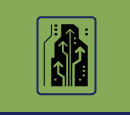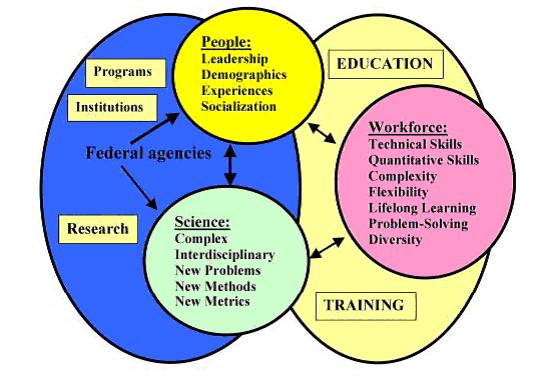

|
|
||
|
Part III Conclusion: Toward a New Vision for the Enterprise of Science
Multiple conversations were going on at the
workshop. Some were addressing the human resource
issues such as educational experiences, demographics
and socialization of females and minorities. Others
were addressing the changing dynamics of the
workforce and the skills needed to enter it. Others
were focusing on the educational pathways and how to
keep students engaged in STEM topics all along the
way. Still others were looking at the problem
through the lens of science, the perceptions of what
is “real” science, who has the capacity to do
research, and how a peer review process leading to
funded programs encourages status quo. What emerged
was a complex picture of the many factors that need
to be addressed simultaneously if real and enduring
change is to take place (Figure 2). |
||
|
Figure 2: Change requires an integrated view of
people, institutions, programs, research and
science. |
||
|
At the beginning of the workshop,
the participants were asked to go beyond considering
ways to accelerate the progress of existing and
proposed programs. They also were asked to identify
paradigm shifts that might enable funding agencies,
academia, industry, and the broader society to
consider the problem of broadening participation in
STEM careers in new and different ways. In
considering these more fundamental and wide-ranging
changes, workshop participants focused on the
difference between building capacity and realizing
capability. For example, the National Science
Foundation has defined its goals to be the
development of People, Ideas and Tools as they all
relate to the scientific enterprise, broadly
defined. Typically, people in the STEM workforce are
viewed as instruments for building and supporting
the research enterprise. |
||
| Many
workshop participants agreed on the necessity to
redefine this model, so that the focus of the
enterprise is people, and the STEM disciplines are
instruments for promoting the health and economic
welfare of all people. Ideas and tools are deployed
for the full realization of the potential of all
people, who in turn generate more diverse and better
ideas and tools. Seen in this light, the internal
dynamics of the research process are an integral
part of the conduct of science, not an afterthought.
It became clear that some groups will need more
resources and support than others all along the
multiple STEM pathways in order to enjoy full
participation in the workforce of the future. In the
past, the United States has neglected to engage all
sectors of its population in the conduct of science
(Committee on Equal Opportunities in Science and
Engineering, 2002). The workshop strongly recommends
that policy makers encourage the development of a
network of pathways that allows students from
diverse backgrounds to achieve success in a range of
roles, such as researcher, educator, evaluator,
industry leader, or entrepreneur. Realizing the capability of all its citizens requires that the nation’s policy makers view the development of human resources as inseparable from the goal of expanding the research frontier. Developing people to their full intellectual potential and developing a vibrant science and engineering enterprise should be seen as a synergistic, two-way relationship, with both aspects being of equal importance and dependent upon each other for success. |

